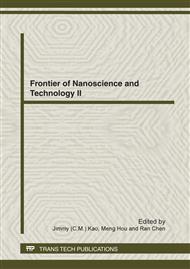p.180
p.184
p.188
p.193
p.197
p.202
p.206
p.210
p.214
Preparation and Thermal Properties Characterization of Cholesterol-Modified Amphiphilic Chitosan
Abstract:
In this article, cholesterol 3-hemisuccinate (CHS) was synthesized through the functionalization of the end group of liquid crystal monomer cholesterol with succinic anhydride. Hydrophobic cholesterol modified low molecular weight chitosan (CS-CH) was synthesized by 1-Ethyl-3-(3-dimethylaminopropyl) carbodiimide (EDC)-mediated coupling reaction. Chemical structure, crystalline morphology, and thermal properties of the biological material were characterized by Fourier transform infrared spectroscopy (FTIR), differential scanning calorimetric (DSC), and polarized light microscopy (POM). The results of POM showed that CHS was a kind of crystalline material with liquid crystal property of cholesterol. DSC showed that the melting point and the crystalline temperature of CHS were 188 °C and 145 °C respectively. DSC also showed that CS-CH was a kind of thermoplastic biological material. The max melting temperature decreased from 120 °C to 110 °C with increasing the weight ratio of EDC/CHS to chitosan.
Info:
Periodical:
Pages:
197-201
Citation:
Online since:
June 2012
Authors:
Keywords:
Price:
Сopyright:
© 2012 Trans Tech Publications Ltd. All Rights Reserved
Share:
Citation:


